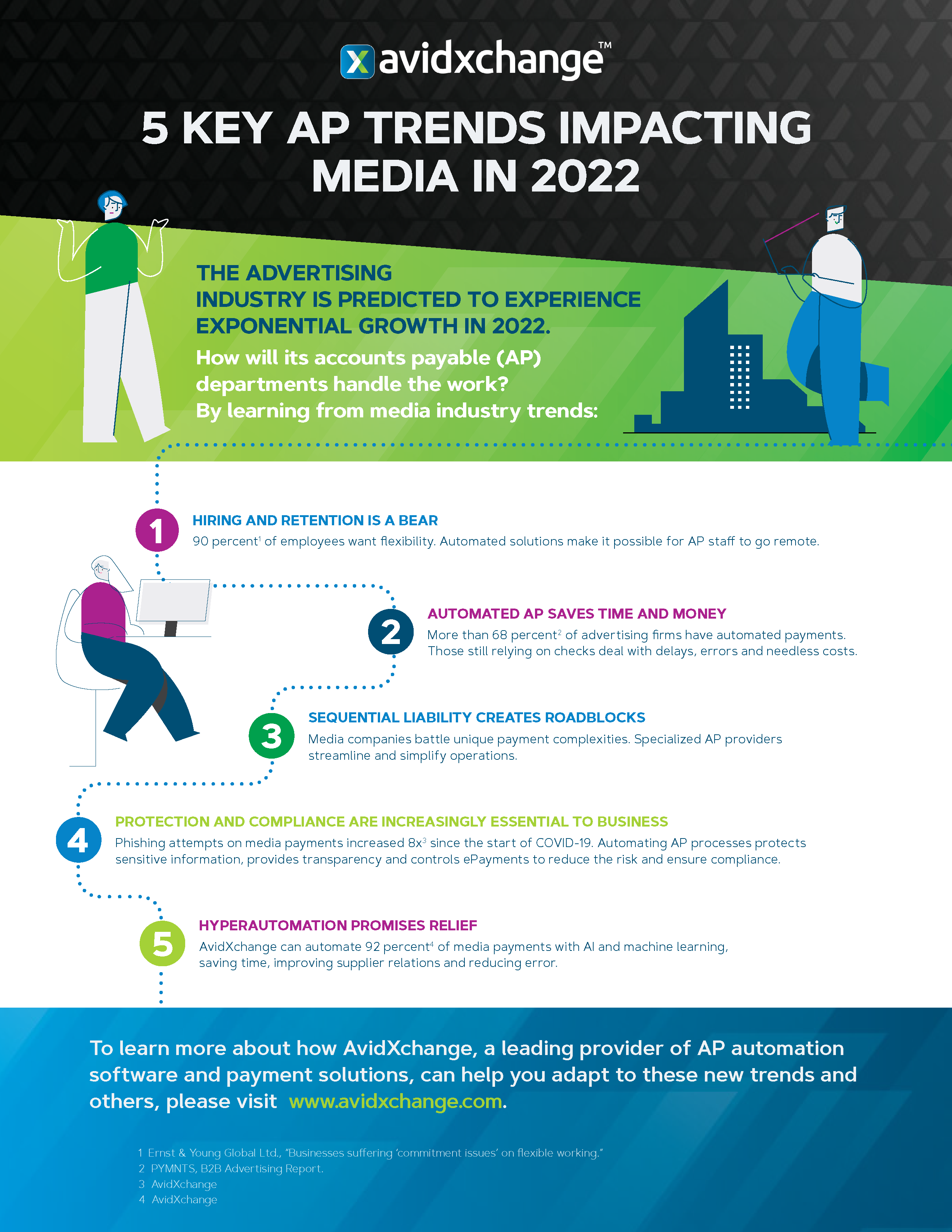The advertising industry was hit hard by the pandemic, down more than $20 billion in 2020, according to Statista. After a swift recovery, it’s predicted to experience exponential growth in 2022.
As ad spending continues to climb and media buying and advertising agencies take on more work, what does it mean for staff that handles the invoicing and payments? A lot of work. And, it demands long-overdue modernization of age-old processes to make it happen.
We’re taking a look at the current state of AP in the media industry and how key industry trends are predicted to impact the way it manages invoicing and payments to better serve and grow their businesses in 2022.

CLICK HERE TO DOWNLOAD THE INFOGRAPHIC
This handy guide outlines the five trends expected to impact the way the media industry manages its invoices and payments in 2022 and beyond.
1. Retention challenges and thin staffs
According to the U.S. Bureau of Labor Statistics, the media industry is projected to grow faster than the average of all industries, but growth isn’t coming easy. Since the start of the pandemic, the media world has been hit especially hard by hiring and retention challenges.
Staffing isn’t a new challenge for media. It’s an industry that tends to employ young professionals who are notorious for job hopping. But, the Great Reshuffle has amplified concerns about how to keep prized talent and attract new people. The strain impacts nearly every role across agencies, from creative to those who handle accounts payables (AP) and payments.
Heavy attrition and a competitive job market means that teams need to do more work with less. And, when people leave, they take with them knowledge, training, and processes that have to be re-taught to new hires, putting critical processes in jeopardy and additional strain on overflowing plates.
Agencies are leaning heavily on technology to ensure valuable data stays with them and is easily accessible. They are also looking to create more streamlined, less time consuming processes for their often complex invoice and payment processes.
As hiring and retention challenges continue in 2022, it’s likely that agencies will ramp up their efforts to eliminate paper processes with automated solutions. Those automated AP solutions will help in securing younger talent who are more likely to choose a tech-savvy employer than one that still depends on paper and cumbersome processes.
2. Continued embrace of end-to-end AP automation solutions
Many media agencies shifted to automated AP at the start of the pandemic, simply out of necessity. It was the only way they could ensure the bills got paid.
Those who have started to automate reap numerous benefits, such as faster invoicing and better visibility, and AP pros have more time to spend on more strategic directives rather than shuffling paper.
Some agencies have already invested in complete invoice to payment AP automation solutions. According to a B2B Advertising Report in PYMNTS, more than 68 percent of advertising firms are now using automated payments processes, seen as the last step of AP automation.
That means nearly one-third of agencies are still using paper checks. Of those check users surveyed by Forrester, more than half have experienced late payments and manual errors, and 40 percent have even lost checks. These mistakes are costly: 30 percent have paid additional processing and material costs and 21 percent have had to cover additional labor costs.
“The irony of paper check payments is that agencies can serve an ad to a target’s phone in nanoseconds, yet it can take months to get that ad paid,” said Rick Weir, vice president of marketing for FastPay.
According to a Forrester report, “as the volume of suppliers dramatically increases, many media companies are wasting valuable time and money on slow and error-prone payment processes.”
As hybrid work environments become the norm for many, agencies will more heavily depend on automation and complete adoption of AP functions is likely to rise.
3. Reduced liability, simple payments powered by AP automation
One of the unique challenges for the media industry is sequential liability, a complex rule that says a company does not pay what they owe until they receive money that is owed to them for the same work. It’s complicated. Part of the headache is that a Net 30 vendor term can quickly become a Net 120, which can significantly strain cash flow.
Automation can assist with the net scramble and ease complexities. Providers can offer more competitive credit terms and better reconciliation, and they provide succinct remittance data that makes it easier for agencies to manage the slew of invoices they receive from their complex network of partners and suppliers.
Agencies who depend on an AP automation partner also have the advantage of not having to field status calls from vendors wanting to know when they’ll receive payment. Automation provides transparency and invoice visibility so those questions are easily answered, and often fielded by an agency’s automation provider.
But, not all automation providers are equal and not all can handle the unique payment complexities in the media world. Industry players demand an AP automation provider who gets their intricacies.
“Media companies often come to us because we integrate with their accounting systems and their media buying platforms. We understand their world because we specialize in it and all of our agency clients are paying the same set of suppliers. From historical payment data, we know how those suppliers prefer to get paid, down to the invoice nuance, and how our clients can monetize those payments."
Theresa Contario, Vice President of Sales, FastPay
4. Enhanced cybersecurity measures
Because of the digital nature of their business, media companies are among the most likely targets of phishing campaigns—cybercrime that has soared since the start of the pandemic.
AvidXchange media clients have reported a three to eight times increase in phishing attempts on media payments since the start of the COVID-19 pandemic.
Firms victimized by cybercrime like phishing attacks and check fraud often turn to automation, looking to do what they realize they should have already done. Automating AP processes protects sensitive information, provides transparency and controls, and offers safer ePayments to help agencies reduce the risk of fraud.
It also ensures compliance requirements are met and puts the diligence work on automation providers, rather than an agency having to handle it.
In 2022, firms will likely lean heavily on their automated AP solutions to help ward off threats and ensure safety and compliance. Those who still depend on manual, paper-based processes will likely consider more robust cybersecurity another compelling reason to automate.
5. Looming compliance challenges
There’s chatter around cutting-edge technologies like AI, robotics and machine learning. It’s happening among media AP teams at bigger agencies, and also at smaller firms that are bursting at the seams and looking for relief. It’s for good reason. Gartner estimates that next-level technologies can reduce operational costs by 30 percent, saving organizations across industries both money and time.
In 2021, AP teams evolved from chatting about and Googling hyperautomation to calling their automation providers for insights and know-how.
“We can now automate up to 92 percent of payments with AI and machine learning. It’s a game-changer, especially for smaller firms that were trying to manage payments through their corporate credit card with no reconciliation. AI saves incredible time, improves supplier relationships, and reduces the risk of error. The list of benefits goes on and on.”
Rick Weir, Vice President of Marketing, FastPay
It’s likely the adoption of the new technologies will continue to advance as AP teams get more up to speed about the value they can bring to their work and their organizations. They’ll continue to rely on their AP automation providers to lead the way.



